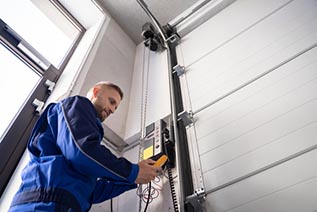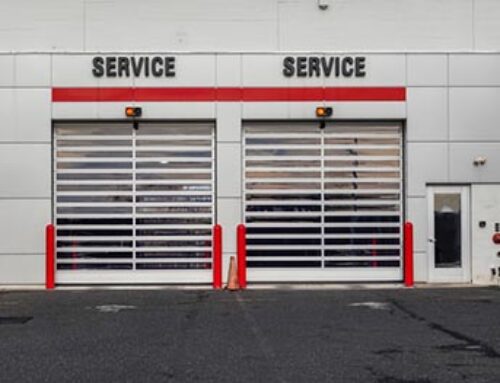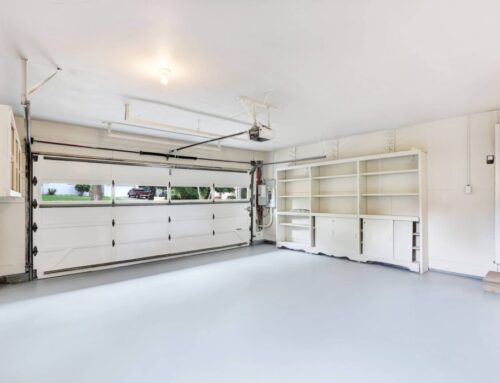A garage door is a large, motorized door typically used to secure the entrance to a garage. It operates on a system of various components that work together to allow the door to open and close smoothly. Here’s a basic overview of how a typical garage door works:
- Door Panels: Garage doors are usually made of multiple horizontal panels that are hinged together. The number of panels may vary based on the size and design of the door.
- Tracks:
- Vertical Tracks: Garage doors typically have two vertical tracks, one on each side of the door frame. These tracks are installed from the floor to the top of the door opening. They serve as guides for the door panels, ensuring that the door moves in a straight and stable path.
- Horizontal Tracks: In some garage door systems, there might be horizontal tracks as well. These are positioned near the ceiling and help stabilize the door during its travel. The horizontal tracks are usually connected to the vertical tracks with curved sections, forming a complete path for the rollers.
- Material: Garage door tracks are usually made of durable steel, which provides the necessary strength and support to handle the weight of the door.
- Mounting: Tracks are securely attached to the garage’s framing using brackets and fasteners. Proper installation is crucial to ensure the door’s smooth operation and longevity.
- Rollers:
- Rollers are small wheels that are attached to the sides of each garage door panel. They move along the tracks, allowing the door to slide open or closed smoothly and with minimal friction.
- Material: Garage door rollers are commonly made of steel or nylon. Steel rollers are sturdy and suitable for heavy doors, while nylon rollers are quieter and do not require lubrication, making them a popular choice for residential garage doors.
- Ball Bearings: High-quality rollers often have ball bearings integrated into their design. These ball bearings reduce friction, making the door much easier to open and close.
- Types: There are two main types of rollers used in garage doors:
- Tire-Style Rollers: These have a wheel-like appearance and are made of rubber or other materials with good traction. They are commonly used in residential garage doors.
- Stem-Style Rollers: These have a stem that extends from the roller wheel and fits into a bracket on the garage door panel. They are frequently found in commercial and heavy-duty garage doors.
- Torsion Springs: Torsion springs are mounted above the garage door, usually along a metal bar called the torsion shaft. These springs store energy when the door is closed and release it when the door is opened, counterbalancing the weight of the door and making it easier to lift manually or with a motor. Torsion springs are an integral part of many garage door systems. They play a crucial role in counterbalancing the weight of the garage door, making it easier to open and close manually or with the assistance of a motorized opener. Here’s some more information about torsion springs:1. Design and Placement:
- Torsion springs are coiled springs designed to store mechanical energy when they are twisted or wound.
- They are typically mounted horizontally above the garage door, parallel to the top of the door opening.
- The springs are installed on a metal shaft called the torsion shaft, which runs through the center of the springs and serves as the axis of rotation.
2. Counterbalancing Function:
- When the garage door is closed, the torsion springs are under tension, as they have been wound up.
- This tension stores energy in the springs, and it acts as a counterbalance to the weight of the door. The springs effectively offset the force of gravity, making the door feel lighter and more manageable to lift manually or with the assistance of an opener.
3. Opening and Closing:
- When you activate the garage door opener to open the door, the motor turns the torsion shaft, which unwinds the torsion springs.
- As the springs unwind, they release the stored energy, which helps lift the door. This process makes the door feel weightless and requires less force to raise it.
- Similarly, when closing the door, the torsion springs wind up again, storing energy to assist with the downward motion.
4. Lifespan and Maintenance:
- Torsion springs have a limited lifespan and are typically rated for a certain number of cycles (a cycle refers to one full open and close of the door).
- The lifespan of torsion springs depends on factors such as the quality of the springs, the weight of the garage door, and how frequently the door is operated.
- Regular maintenance, such as lubricating the springs and other moving parts, can help prolong their lifespan and ensure smooth operation.
5. Safety Considerations:
- Torsion springs are under high tension, and if not handled properly, they can be dangerous to work with.
- When a garage door spring breaks, it can release a significant amount of force and cause injury or property damage.
- For this reason, it’s important to leave spring repair and replacement to trained professionals who have the necessary tools and expertise to handle these components safely.
- Cables and Pulleys: Cables run from the bottom corners of the door and are attached to a system of pulleys. These cables help distribute the tension from the torsion springs and keep the door aligned as it moves.
- Motor and Opener:Garage door openers are motorized devices that automate the process of opening and closing garage doors. They offer convenience, security, and safety by allowing homeowners to operate the garage door with the push of a button or through other control methods. Here are some key features and details about garage door openers:
1. Types of Garage Door Openers:
- Chain-Drive Openers: These are among the most common and affordable types of openers. They use a metal chain to pull or push the trolley that moves the door along the tracks. While durable, they can be noisier compared to other options.
- Belt-Drive Openers: These openers use a rubber or polyurethane belt instead of a chain, resulting in quieter operation. They are suitable for garages located below or adjacent to living spaces.
- Screw-Drive Openers: These openers have a threaded steel rod that rotates to move the trolley. They are known for their simplicity and reliability, requiring less maintenance. However, they can be a bit noisier than belt-drive openers.
- Direct-Drive Openers: Also known as jackshaft openers, these units are mounted on the wall beside the garage door. They use a motor to turn a gear that drives the torsion shaft directly, eliminating the need for belts or chains. Direct-drive openers are quiet and ideal for garages with limited headroom.
- Smart Openers: Modern garage door openers often come with smart features, allowing homeowners to control their garage doors remotely through smartphone apps. Smart openers may also integrate with home automation systems like Google Assistant or Amazon Alexa, providing added convenience.
2. Safety Features:
- Most garage door openers come with safety features to prevent accidents and injuries. These may include:
- Photoelectric Sensors: These sensors are placed near the bottom of the door’s tracks and emit an invisible beam. If the beam is interrupted, such as by an object or person in the door’s path, the opener will reverse the door’s direction to prevent closing on the obstruction.
- Auto-Reverse Mechanism: This feature automatically reverses the garage door if it encounters resistance while closing. If something is in the way of the door, it will reverse direction to avoid causing damage or injury.
3. Power and Horsepower:
- Garage door openers are available in various power options, typically ranging from ½ to 1 ¼ horsepower (HP). The horsepower required depends on the size and weight of the garage door.
- Sensors and Safety Features: To ensure safety, modern garage doors often have sensors that detect obstructions in the door’s path. If an object is detected while the door is closing, the sensor will send a signal to reverse the door’s direction, preventing accidents or damage.
Now, when you want to open or close the garage door:
- When you activate the motor through the opener (using a remote or other methods), it sends a signal to the motor to start running.
- The motor turns a drive mechanism (usually a belt, chain, or screw) that connects to the torsion shaft. As the torsion shaft rotates, it winds or unwinds the torsion springs.
- The springs, either winding up or unwinding, create the force needed to lift or lower the heavy garage door.
- The door panels, guided by the tracks and rollers, move along the vertical tracks, either rising to open or descending to close the garage door.
- The safety sensors monitor for any obstructions, and if anything is detected, the door will stop and reverse its direction to prevent accidents.
That’s a basic rundown!






